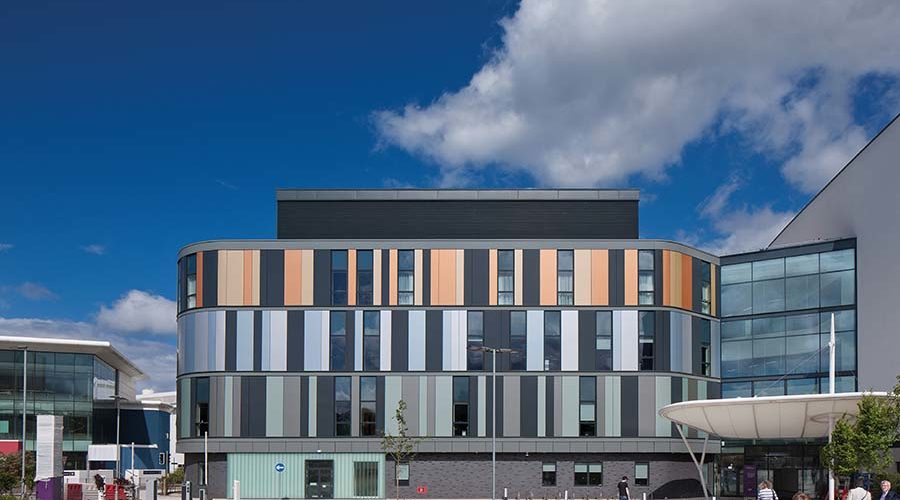NHS Lothian’s new Royal Hospital for Children and Young People and Department of Clinical Neurosciences officially opened its doors earlier this year, bringing together all children’s services formerly located at Sciennes into one inspiring place.
HLM
Located next to the Royal Infirmary of Edinburgh at Little France, the hospital, designed by HLM Architects, brings together outpatient and inpatient facilities for paediatric care, specialist neonatal care, neurosciences and adult and children’s emergency departments, creating a centre of excellence for staff and patients alike.
The design has delivered a fantastic new identity for the Royal Hospital for Children and Young People and Department for Clinical Neurosciences (RHCYP and DCN), which redefines and improves the entire arrival experience for those approaching the Royal Infirmary of Edinburgh.
Lorraine Robertson, Director at HLM Architects, said: “We are very excited to see this new state-of-the-art hospital become fully operational. The building has been designed as a flexible, modern space, built entirely around patient needs across its new wards, theatres, and therapy and emergency departments, greatly enhancing the healthcare provisions available to children and young people across Edinburgh and beyond.”
The design team shared NHS Lothian’s ambition to further improve its status as a world-class service provider enabled by an excellent built environment.
The site has been arranged into three distinct elements and easily identifiable component parts that reflect and respond to the client’s clinical brief, design statement and ethos statement. The ‘Podium’ defines the edge of an extended public realm that connects all the main arrival points from Old Dalkeith Road to the new Hospital Square. The curved spine wall forming the edge of the podium becomes a strong visual feature, encompassing bespoke artwork developed with staff and patients. This defines the extent of the new unifying high-quality public realm and differentiates public and private areas. It provides a wonderful, grassed area that gently sweeps up, creating a private, secure setting for the CAMHS unit, giving the building its own unique setting within the hospital campus.
Sitting within and on the podium, ‘Big Brother’ is the acute block containing all facilities that are shared, including the diagnostic and treatment core and the main ward accommodation. The vibrantly-coloured ‘Little Brother’ then becomes the children’s hospital outpatient facility with the pod space at its heart, full of life and activity. Little Brother sits independently of the Podium and is located within the public realm, defining both the entrance to the RHCYP to the south and the entrance to the DCN to the north of a shared top-lit atrium and street space.
Throughout the design of the project, continued design ownership was encouraged with staff and end users – listening, encouraging and harnessing the passion and motivation of all contributors.
Calum Campbell, Chief Executive at NHS Lothian, said: “Our wish for this project was for it to be designed in collaboration with patients and their families, as well as our staff, and the facilities that are available within the Royal Hospital for Children and Young People Department for Clinical Neurosciences are testament to the success of that approach.
“The spaces are welcoming, but also fun; intended to put children and young people at ease at a time when they might otherwise be frightened, unsure or upset. The designed space is complemented by the inclusion of the latest clinical thinking and technology, enabling our teams to provide the best treatment and care for our patients not just now, but for years to come.”
Understanding the challenges that come with delivering a facility that takes account of the demands of different service users from children with physical and mental healthcare needs to vulnerable adults who require investigation and treatment for neurological conditions was key. This has been accomplished through an approach that is inclusive, open, honest, client/person centred, evidence based and outcome driven.
The simple arrangement of the principle building elements, such as arrival experience, entrances, light, scale, materials, finishes, art and wayfinding, ensure that each area has its own specific character albeit derived from a unified concept for the whole building. A friendly and welcoming environment starts on the approach to the building through the significant public realm. It continues throughout with provision of a caring and reassuring atmosphere which feels non-institutional through the integration of art throughout. Clear identities for departments and information points eliminate confusion and reduce anxiety.
A key aspect of the building is the art and therapeutic design programme which was commissioned based on extensive research which demonstrates that art and therapeutic design can help reduce stress and promote patient recovery.
The large-scale programme was funded through a £3.1m cash injection from the Edinburgh Children’s Hospital Charity and another £2m from the Edinburgh and Lothians Health Foundation. More than 20 projects, and 30 different artists, were curated and produced by art and design consultant, Ginkgo, which worked with patients young and old to create a totally unique programme in what is the largest capital commission for art in a new hospital in the UK.













